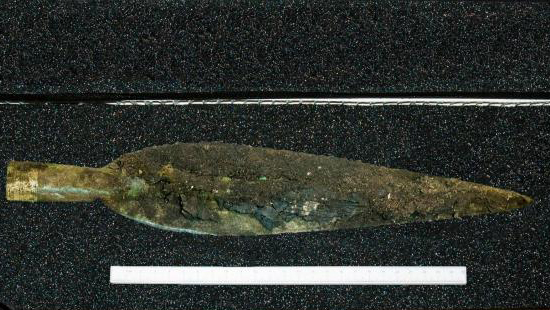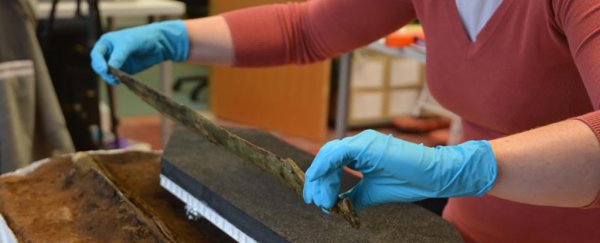A bronze sword, a gold-decorated spearhead, well-preserved sheath fittings, and fur skins – all thought to date back to around 3,000 years – are some of the remarkable finds uncovered at a dig currently underway in the UK.
Archaeologists on the site have described it as the "find of a lifetime" and continue to uncover the remains of dwellings, pots, and other artefacts, so there could be more to come from this treasure trove of ancient relics.
The items have been uncovered near the town of Carnoustie, in the council area of Angus on the east coast of Scotland.
Experts from GUARD Archaeology, commissioned to carry out the dig, say that it's a "rare and internationally significant hoard" that can teach us a lot more about Bronze Age living (and fighting) in the area.
"It is very unusual to recover such artefacts in a modern archaeological excavation, which can reveal so much about the context of its burial," project officer Alan Hunter Blair from GUARD Archaeology told BBC News.
The sword is very well preserved, according to archaeologists, but it's the accompanying spearhead that's really exciting – only a handful of such gold-marked spearheads have ever been uncovered in Britain.
 GUARD Archaeology
GUARD Archaeology
"The earliest Celtic myths often highlight the reflectivity and brilliance of heroic weapons," says Blair. "Gold decoration was probably added to this bronze spearhead to exalt it both through the material's rarity and its visual impact."
Organic remains, which very rarely survive intact this long underground, have also been dug up, including a leather and wooden scabbard, fur skin protecting the spearhead, and textile around the scabbard and pin.
What makes the site even more special – as if it needed anything else – is the discovery of settlements around the weapons, which gives archaeologists some useful context when it comes to working out how these communities lived.
The team has also come across the biggest Neolithic hall ever found in Scotland, thought to date back an incredible 6,000 years. That means the hall would have been as old to the Bronze Age settlers as the sword and spearhead are to us.
Archaeologists say that Carnoustie seems to have been a hive of activity for many thousands of years, but it's not clear yet whether the spot was inhabited between the Neolithic and Bronze Age periods, or whether there was a gap between settlements.
The work at the site goes on. Excavation was commissioned ahead of a couple of kids' soccer pitches being built on the spot, and it may be a while yet before the children of the area can pull on their boots.
It's also going to take a while for the team to get enough details to present their research in a peer-reviewed paper, so until then we have to take the discoveries with a grain of salt. But we'll be watching progress closely.
"The discoveries made on land destined for sporting development have given us a fascinating insight into our Angus forebears and I look forward to learning more about our local prehistory," says local councillor Donald Morrison.
